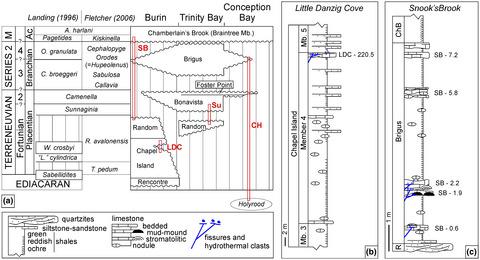当前位置:
X-MOL 学术
›
Basin Res.
›
论文详情
Our official English website, www.x-mol.net, welcomes your
feedback! (Note: you will need to create a separate account there.)
Cambrian syn‐rift tectonic pulses at unconformity‐bounded carbonates in the Avalon Zone of Newfoundland, Canada
Basin Research ( IF 2.8 ) Pub Date : 2020-11-01 , DOI: 10.1111/bre.12525 J. Javier Álvaro 1
Basin Research ( IF 2.8 ) Pub Date : 2020-11-01 , DOI: 10.1111/bre.12525 J. Javier Álvaro 1
Affiliation

|
In the Avalon Zone of SE Newfoundland, several Terreneuvian to Cambrian Series 2 carbonate bodies occur associated with paraconformities and onlapping geometries. Their stratigraphic discontinuities and related gaps represent syn‐rift episodes characterized by sharply tilted and downfaulted blocks and deposition of chaotic megabreccia beds and conglomerates on neighbouring footwall areas. Microbial and shelly carbonate production nucleated on tectonically unstable palaeohorsts, where stromatolitic crusts and mats commonly reflect the onset of hiatal stratigraphic diastems, and mud‐mounds the episodic establishment of calm conditions. Short‐term uplift episodes of rift shoulders led to unroofing of the Neoproterozoic basement (yielding granitoid clasts and input of reworked exotic clasts and allochthonous fossils from underlying Cambrian strata), localized subaerial exposure and karst features, and the development of synsedimentary fracture networks that provided favourable conduits and pathways for hydrothermal fluids. These carbonate beds host vein networks of carbonate‐hosted polymetallic sulphide‐sulphate‐oxide mineral associations (Pb–Cu–Fe–barite stockworks). The mixture of parautochthonous and allochthonous bioclastic assemblages points to the record of event‐concentration strata, which may clarify the long stratigraphic ranges of some involved microfossils. The Cambrian Avalonia rift and the offshore to basinal rift sector of the neighbouring Atlas‒Ossa‐Morena rift, preserved in the Moroccan northern High Atlas and Coastal Meseta, share common temperate‐water carbonate facies and build‐ups, lacking ‘subtropical’ indicators such as archaeocyathan‐microbial reefs, ooidal shoals or evaporitic pseudomorphs. These diagnostic facies and minerals occur only in relatively stable, shallow‐water rift branches, such as those preserved in the Anti‐Atlas and the Ossa‐Morena Zone (Iberian Massif).
中文翻译:

加拿大纽芬兰阿瓦隆地区不整合边界碳酸盐岩寒武纪构造裂变
在纽芬兰东南部的阿瓦隆地区,出现了几个Terreneuvian到Cambrian系列2的碳酸盐岩体,它们与顺形和重叠的几何形状有关。它们的地层不连续性和相关的间隙代表了同裂谷现象,其特征是陡峭倾斜和断层的块体,以及邻近的下盘壁区域上堆积了混乱的角砾岩床和砾岩。微生物和带壳碳酸盐的产生在构造不稳定的古地壳上成核,层间质的地壳和垫层通常反映出裂隙性地层困境的发生,并淤积了平静条件的偶发性建立。裂谷肩部的短时隆起导致新元古代基底的屋顶隆起(产生的花岗岩类碎屑和来自底层寒武纪地层的重做的外来碎屑和异源化石的输入),局部地下动脉暴露和岩溶特征,以及同沉积裂缝网络的发展,为热液流体提供了有利的管道和路径。这些碳酸盐床的碳酸盐岩托管的多金属硫化物-硫酸盐-氧化物矿物质联合体(铅-铜-铁-重晶石原料厂)的脉络网络。旁生生物碎屑组合和异源生物碎屑组合的混合物指出了事件集中地层的记录,这可能澄清了某些涉及的微化石的长地层范围。寒武纪的阿瓦隆大裂谷和邻近的阿特拉斯-奥萨-莫雷纳大裂谷的海底至盆地裂谷断层,保存在摩洛哥北部的高阿特拉斯和梅西塔海岸,它们具有共同的温带-水碳酸盐岩相和构造,缺乏诸如“亚热带”的指示作为古珊瑚礁 卵形浅滩或蒸发的假晶状体。这些诊断相和矿物仅在相对稳定的浅水裂谷分支中发生,例如保存在Anti-Atlas和Ossa-Morena区(伊比利亚地块)中的那些。
更新日期:2020-11-01
中文翻译:

加拿大纽芬兰阿瓦隆地区不整合边界碳酸盐岩寒武纪构造裂变
在纽芬兰东南部的阿瓦隆地区,出现了几个Terreneuvian到Cambrian系列2的碳酸盐岩体,它们与顺形和重叠的几何形状有关。它们的地层不连续性和相关的间隙代表了同裂谷现象,其特征是陡峭倾斜和断层的块体,以及邻近的下盘壁区域上堆积了混乱的角砾岩床和砾岩。微生物和带壳碳酸盐的产生在构造不稳定的古地壳上成核,层间质的地壳和垫层通常反映出裂隙性地层困境的发生,并淤积了平静条件的偶发性建立。裂谷肩部的短时隆起导致新元古代基底的屋顶隆起(产生的花岗岩类碎屑和来自底层寒武纪地层的重做的外来碎屑和异源化石的输入),局部地下动脉暴露和岩溶特征,以及同沉积裂缝网络的发展,为热液流体提供了有利的管道和路径。这些碳酸盐床的碳酸盐岩托管的多金属硫化物-硫酸盐-氧化物矿物质联合体(铅-铜-铁-重晶石原料厂)的脉络网络。旁生生物碎屑组合和异源生物碎屑组合的混合物指出了事件集中地层的记录,这可能澄清了某些涉及的微化石的长地层范围。寒武纪的阿瓦隆大裂谷和邻近的阿特拉斯-奥萨-莫雷纳大裂谷的海底至盆地裂谷断层,保存在摩洛哥北部的高阿特拉斯和梅西塔海岸,它们具有共同的温带-水碳酸盐岩相和构造,缺乏诸如“亚热带”的指示作为古珊瑚礁 卵形浅滩或蒸发的假晶状体。这些诊断相和矿物仅在相对稳定的浅水裂谷分支中发生,例如保存在Anti-Atlas和Ossa-Morena区(伊比利亚地块)中的那些。











































 京公网安备 11010802027423号
京公网安备 11010802027423号